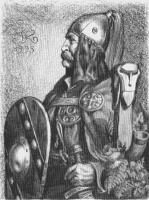0

















| Thumbs Up |
| Received: 7 Given: 0 |

Same as in the picture Jarl.
The Swedish log-house or lafting tradition started in Sigtuna in the first half of the 11th century and then spread rapidly in central and north Sweden. The technique were used in part of Danevirke and in a well construction or two during the Viking age in Scandinavia but was not part of the house building tradition until Sigtuna (and Oslo and Tromsö, starting at the same time).
From ca 700 e. Kr. houses and forts were lafted on the Baltic east-coast in today’s Poland, the Baltic’s and Russia and bit later in Ladoga and Novgorod. Wladyslaw Duczko, archaeologist in Uppsala believes that the west-Slavs are an important transmitter for the Scandinavian tradition.












| Thumbs Up |
| Received: 32 Given: 0 |

Thanks!
Both Balts and Slavs were known for building wooden forts or earthworks at unstable times or as means of defence against nomadic steppe tribes.
20-30 years ago it was assumed that Slavs originated from Zarubintsy-Kiev cultures (the so called Godlowski hypothesis). However, in the past 10 year new archeological evidence concerning the Przeworsk and Zarunbintsy cultures instigated a new debate. There is some evidence which might suggest origins in the Pommeranian culture. Late Przeworsk settlements survive as far as VII century AD in Grosspoles. On the same area the lechitic Sukow-Szeligi culture forms in late V early VI century, expanding into Vorpommern. The material culture of late Przeworsk and Sukow-Szeligi is very similar and many modern scholars suggest some form of continuity. Also other Slavic cultures like Feldberg and Tornow, closely resemble cultures from Poland in antiquity. There are striking differencec between these cultures and the larges Slavic culture of Prague-Korchak. At the same time, Ukrainian and Russian scholars (Siedow, Tretiakow, Baran, Pobol, Oblomski, Terpilovski and many others) established in the past 20 years that Kiev culture descends directly from Zarubintsy, while Zarubintsy from the Pommeranian. This is also supported by some Lithuanian scholars (like Petrauskas and Gimbutas).
Now... it might be possible that Slavic-Scandinavian contacts reach as far as antiquity and arrival of Goths, Vandals, Gepids in Pomerania, and the Chernyakov culture. In any case, contacts between Scandinavia and Pomeranian Slavs have always been intense. Apparently, whole Southern coast of Baltic, from Jutland to Truso was littered with Scandinavian emporia, so it is not astonishing that some Slavs could settle in Scania or some other place. Also Danish and Obodrite elites intermarried. Harald Bluetooth forged an anti-Saxon alliance with the duke of the Obodrites, marrying his daughter.
Few more links:
http://www.uppakra.se/docs/uppakra7/19_Helgess_U7.pdf
http://viking.hgo.se/Newsletter/NEWS5.pdf
It is worth noting that the firth king of Poland, Boleslaw I the Brave (967 – 1025) was called "Rex Gothorum et Polonarum"... most likely a distant reflection of former the Gothic-Venedic coexistence.
Anyway, I doubt there has existed any community of Slavs in Frisia. Apart from Obodrite raids, I know nothing about any special Slavic-Frisian connections. The accounts of Danish and Slavic raids on Frisian settlements are in the chronicles of Helmond and Widukind.
Last edited by Jarl; 04-27-2009 at 09:36 PM.














| Thumbs Up |
| Received: 9 Given: 1 |

First king of Poland Bolesław The Great (Chrobry), rather. Some sources identified him with Bursleif from sagas...Gothic-Venedic coexistence
bit controversial maybe rather Gothic-Vandalic?...Probably some old monk read once about Goths in Poland territorrys(after Poland even existed ofcourse). Poor brother didn't read(cause no one even wrote) about brave people from North Eastern European swamps...But you're rather autochtonist right?













| Thumbs Up |
| Received: 1 Given: 0 |

I knew Karl Pilkington looked Polish.














| Thumbs Up |
| Received: 2 Given: 0 |

The Goths and Vandals were responsible for any Slavic heritage in Scandinavia because of their Baltic location, on the amber trail.
There are currently 1 users browsing this thread. (0 members and 1 guests)
Bookmarks